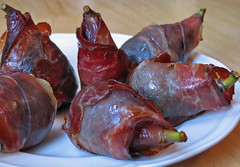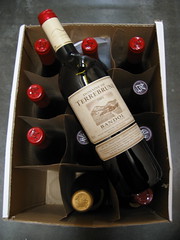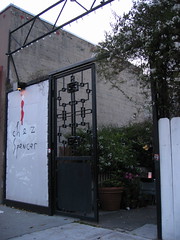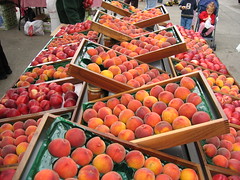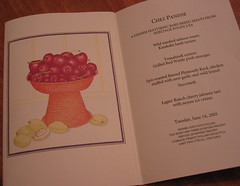Melissa and I eagerly arrived at Chez Spencer for a "date" a couple of weeks ago. The unabashedly French restaurant gets the nod from Patricia Unterman and the Chronicle, and the enclosed front patio suggested a more cozy evening than the high ceilings and open floor plan of the boisterous interior.
After we settled under the gas heater, Melissa looked over the tasting menu while I mentally evaluated the wine list, a compulsive habit ever since I started researching the subject for an upcoming article. Chez Spencer's list, dense type covering a single side of a tall piece of paper, is not particularly novel or compelling, though someone has taken the time to organize the wines by style rather than region ("Aromatic Whites" instead of "Germany," for example). Rather than pick a bottle, we chose to order the five-course tasting menu ($75) with optional wine pairing ($35). The restaurant lets you choose between two options for every course, but Melissa chose the plates I wanted, and we sheepishly ordered the same meal.
The first course featured three raw Kumamoto oysters, paired with an unfiltered 2003 Sancerre (Sauvignon Blanc) from Hubert Brochard. It's unfortunate that the restaurant decided to dress our oysters with a strong mignonette sauce. I prefer my dressings on the side, so that I may decorate my oysters as I wish, typically with a quick squeeze of lemon. Their approach prevented me from tasting the oysters, and the pungent vinegar in the mignonette overwhelmed the tart Sancerre. On the plus side, I couldn't often tell if the crunchy bits were whole peppercorns or chunks of shell.
The next course offered a better balance: a torchon of foie gras with a Pink Lady apple tart, accompanied by a glass of 2000 Sauternes from Chateau Simon. The dish was good enough, though the wine set a theme for the rest of the meal. Chez Spencer plays it safe with their pairings. This isn't bad, per se, but it suggests the same ennui you sense in the wine list itself, a feeling that no one here has become passionate about creating an interesting wine experience.
There's no doubt the roasted rack of lamb with braised artichokes, fromage blanc, and a lamb jus was the best dish of the evening. Melissa calls it "plate-lickingly good"; I say it was quite good. Either way, you get the point. The wine, a 2001 Chateau de la Gardine Côtes du Rhône Villages, continued the theme of safe, uninspired matches.
And then the cheese course. Sigh. We knew which cheeses were coming because Melissa asked at the beginning. Saint André, Morbier, Saint Agur,a Camembert, a crottin of chevre, and a Petit Basque [edited to get the cheeses right]. It's possible, even probable, that Melissa and I are cheese snobs, but do they really think these are interesting cheeses? They're fine, of course, but I imagine you can get them at any Whole Foods in the country. San Francisco residents have some of the best cheese stores in the U.S.; we should expect to find compelling cheeses at a restaurant charging us $75 to eat there. When the server brought out the cheese plate, he was perplexed when we asked if he had a recommended order. "Well, I've never thought of that," he said. Hopefully now he will, but Melissa and I figured out an order based on our knowledge of the cheeses. The wine was an Alsatian Gewurztraminer.
Dinner closed with a warm apple crèpe with apple cider caramel and Calvados ice cream. Enjoyable, if not entirely seasonal, even in the oddly rainy summer we're having here. A non-vintage Graham Six Grapes Port complemented the dish reasonably well.
I expect a $75 tasting menu to feature pretty good food, and Chez Spencer didn't deliver. Gary Danko offers a five-course tasting menu for $79. The wine pairing costs you an extra $45. That's $14 more than the Chez Spencer meal. For that, you get really good food, the "normal" extras like amuse-bouches, a pretty decent cheese cart, and some interesting wines. The restaurant doesn't seat as many people, and it's very expensive real estate. If you go to Oakland's Citron, a very good five-course tasting menu with interesting cheeses and compelling and thoughtful wine pairings will cost you, total, $66. That's $44 less than Chez Spencer's equivalent. You can guess which we'd go to again, given the choice.

